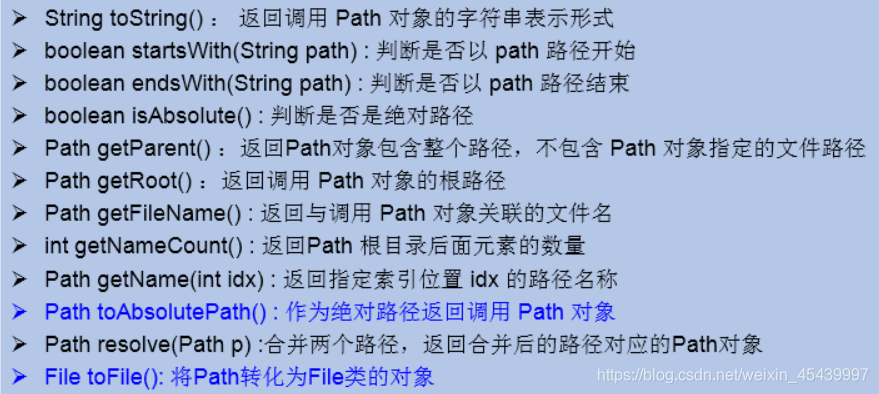
本文共 9625 字,大约阅读时间需要 32 分钟。
学习目标:
Java 高级编程 学习打卡 第十天
学习内容:
1、一个IP对应着哪个类的一个对象?实例化这个类的两种方式是?两个常用的方法是?
InetAddressInetAddress.getByName(String host);InetAddress.getLocalHost();//获取本地ipgetHostName();getHostAddress();
2、传输层的TCP协议和UDP协议的主要区别是?
TCP:可靠的数据传输(三次握手);进行大数据量的传输;效率低
UDP:不可靠;以数据报形式发送,数据报限定为64k;效率高
3、什么是URL,你能写一个URL吗?
URL:统一资源定位符
URL url = new URL(“http://192.168.14.100:8080/examples/hello.txt?username=Tom”);
4、谈谈你对对象序列化机制的理解
序列化过程和反序列化过程
5、对象要想实现序列化,需要满足哪几个条件
1. 实现接口:Serializable 标识接口2. 对象所在的类提供常量:序列版本号3. 要求对象的属性也必须是可序列化的。(基本数据类型、String:本身就已经是可序列化的。)
学习时间:
2021年5月04日
学习产出:
学习总结:
Path、Paths、Files的使用
1、NIO的使用说明
Java NIO (New IO,Non-Blocking IO)是从Java 1.4版本开始引入的一套新的IO API,可以替代标准的Java IO API。
NIO与原来的IO有同样的作用和目的,但是使用的方式完全不同,NIO支持面向缓冲区的(IO是面向流的)、基于通道的IO操作。
NIO将以更加高效的方式进行文件的读写操作。
Java API中提供了两套NIO,一套是针对标准输入输出NIO,另一套就是网络编程NIO。
随着 JDK 7 的发布,Java对NIO进行了极大的扩展,增强了对文件处理和文件系统特性的支持,以至于我们称他们为 NIO.2。
2、Path的使用——jdk7提供
1、Path的说明:
Path替换原有的File类
2、如何实例化:


3、Files工具类——jdk提供
1、作用:
操作文件或文件目录的工具类
2、常用方法:


InetAddress类的使用
实现网络通信需要解决的两个问题
1、如何准确地定位网络上一台或多台主机;定位主机上的特定的应用
2、找到主机后如何可靠高效地进行数据传输
网络通信的两个要素:
1、对应问题一:IP和端口号
2、对应问题二:提供网络通信协议:TCP/IP参考模型(应用层、传输层、网络层、物理+数据链路层)
通信要素一:IP和端口号
1、IP的理解
(1)IP:唯一的标识 Internet 上的计算机(通信实体)
(2)在Java中使用InetAddress类代表IP
(3)IP分类:IPv4 和 IPv6 ; 万维网 和 局域网
(4)域名: www.baidu.com www.mi.com www.sina.com www.jd.com
域名解析:域名容易记忆,当在连接网络时输入一个主机的域名后,域名服务器(DNS)负责将域名转化成IP地址,这样才能和主机建立连接。 -------域名解析
(5)本地回路地址:127.0.0.1 对应着:localhost
2、InetAddress类:此类的一个对象就代表着一个具体的IP地址
(1)实例化
getByName(String host) 、 getLocalHost()
(2)常用方法
getHostName() / getHostAddress()
(3)端口号:正在计算机上运行的进程。
要求:不同的进程不同的端口号
范围:被规定为一个 16 位的整数 0~65535。
端口号与IP地址的组合得出一个网络套接字:Socket
通信要素二:网络通信协议
1、分型模型

2、TCP和UDP的区别

3、TCP三次握手和四次挥手


TCP网络编程
代码示例1:客户端发送信息给服务端,服务端将数据显示在控制台上
//客户端@Testpublic void client() { Socket socket = null; OutputStream os = null; try { //1.创建Socket对象,指明服务器端的ip和端口号 InetAddress inet = InetAddress.getByName("192.168.14.100"); socket = new Socket(inet,8899); //2.获取一个输出流,用于输出数据 os = socket.getOutputStream(); //3.写出数据的操作 os.write("你好,我是客户端mm".getBytes()); } catch (IOException e) { e.printStackTrace(); } finally { //4.资源的关闭 if(os != null){ try { os.close(); } catch (IOException e) { e.printStackTrace(); } } if(socket != null){ try { socket.close(); } catch (IOException e) { e.printStackTrace(); } } }} //服务端 @Test public void server() { ServerSocket ss = null; Socket socket = null; InputStream is = null; ByteArrayOutputStream baos = null; try { //1.创建服务器端的ServerSocket,指明自己的端口号 ss = new ServerSocket(8899); //2.调用accept()表示接收来自于客户端的socket socket = ss.accept(); //3.获取输入流 is = socket.getInputStream(); //不建议这样写,可能会乱码// byte[] buffer = new byte[1024];// int len;// while((len = is.read(buffer)) != -1){ // String str = new String(buffer,0,len);// System.out.print(str);// } //4.读取输入流中的数据 baos = new ByteArrayOutputStream(); byte[] buffer = new byte[5]; int len; while((len = is.read(buffer)) != -1){ baos.write(buffer,0,len); } System.out.println(baos.toString()); System.out.println("收到了来自于:" + socket.getInetAddress().getHostAddress() + "的数据"); } catch (IOException e) { e.printStackTrace(); } finally { if(baos != null){ //5.关闭资源 try { baos.close(); } catch (IOException e) { e.printStackTrace(); } } if(is != null){ try { is.close(); } catch (IOException e) { e.printStackTrace(); } } if(socket != null){ try { socket.close(); } catch (IOException e) { e.printStackTrace(); } } if(ss != null){ try { ss.close(); } catch (IOException e) { e.printStackTrace(); } } } } 代码示例2:客户端发送文件给服务端,服务端将文件保存在本地。
/*这里涉及到的异常,应该使用try-catch-finally处理 */@Testpublic void client() throws IOException { //1. Socket socket = new Socket(InetAddress.getByName("127.0.0.1"),9090); //2. OutputStream os = socket.getOutputStream(); //3. FileInputStream fis = new FileInputStream(new File("beauty.jpg")); //4. byte[] buffer = new byte[1024]; int len; while((len = fis.read(buffer)) != -1){ os.write(buffer,0,len); } //5. fis.close(); os.close(); socket.close();}/*这里涉及到的异常,应该使用try-catch-finally处理 */@Testpublic void server() throws IOException { //1. ServerSocket ss = new ServerSocket(9090); //2. Socket socket = ss.accept(); //3. InputStream is = socket.getInputStream(); //4. FileOutputStream fos = new FileOutputStream(new File("beauty1.jpg")); //5. byte[] buffer = new byte[1024]; int len; while((len = is.read(buffer)) != -1){ fos.write(buffer,0,len); } //6. fos.close(); is.close(); socket.close(); ss.close();} 代码示例3:从客户端发送文件给服务端,服务端保存到本地。并返回“发送成功”给客户端。并关闭相应的连接。
/* 这里涉及到的异常,应该使用try-catch-finally处理 */@Testpublic void client() throws IOException { //1. Socket socket = new Socket(InetAddress.getByName("127.0.0.1"),9090); //2. OutputStream os = socket.getOutputStream(); //3. FileInputStream fis = new FileInputStream(new File("beauty.jpg")); //4. byte[] buffer = new byte[1024]; int len; while((len = fis.read(buffer)) != -1){ os.write(buffer,0,len); } //关闭数据的输出 socket.shutdownOutput(); //5.接收来自于服务器端的数据,并显示到控制台上 InputStream is = socket.getInputStream(); ByteArrayOutputStream baos = new ByteArrayOutputStream(); byte[] bufferr = new byte[20]; int len1; while((len1 = is.read(buffer)) != -1){ baos.write(buffer,0,len1); } System.out.println(baos.toString()); //6. fis.close(); os.close(); socket.close(); baos.close();}/*这里涉及到的异常,应该使用try-catch-finally处理 */@Testpublic void server() throws IOException { //1. ServerSocket ss = new ServerSocket(9090); //2. Socket socket = ss.accept(); //3. InputStream is = socket.getInputStream(); //4. FileOutputStream fos = new FileOutputStream(new File("beauty2.jpg")); //5. byte[] buffer = new byte[1024]; int len; while((len = is.read(buffer)) != -1){ fos.write(buffer,0,len); } System.out.println("图片传输完成"); //6.服务器端给予客户端反馈 OutputStream os = socket.getOutputStream(); os.write("你好,美女,照片我已收到,非常漂亮!".getBytes()); //7. fos.close(); is.close(); socket.close(); ss.close(); os.close();} UDP网络编程
代码示例:
//发送端@Testpublic void sender() throws IOException { DatagramSocket socket = new DatagramSocket(); String str = "我是UDP方式发送的导弹"; byte[] data = str.getBytes(); InetAddress inet = InetAddress.getLocalHost(); DatagramPacket packet = new DatagramPacket(data,0,data.length,inet,9090); socket.send(packet); socket.close();}//接收端@Testpublic void receiver() throws IOException { DatagramSocket socket = new DatagramSocket(9090); byte[] buffer = new byte[100]; DatagramPacket packet = new DatagramPacket(buffer,0,buffer.length); socket.receive(packet); System.out.println(new String(packet.getData(),0,packet.getLength())); socket.close();} URL编程
1、URL(Uniform Resource Locator)的理解:
统一资源定位符,对应着互联网的某一资源地址
2、URL的5个基本结构:
http://localhost:8080/examples/beauty.jpg?username=Tom协议 主机名 端口号 资源地址 参数列表
3、如何实例化:
URL url = new URL(“http://localhost:8080/examples/beauty.jpg?username=Tom”);
4、常用方法:
URL url = new URL("http://localhost:8080/examples/myTest.txt");System.out.println("getProtocol() :"+url.getProtocol());System.out.println("getHost() :"+url.getHost());System.out.println("getPort() :"+url.getPort());System.out.println("getPath() :"+url.getPath());System.out.println("getFile() :"+url.getFile());System.out.println("getQuery() :"+url.getQuery()); 5.可以读取、下载对应的url资源:
public static void main(String[] args) { HttpURLConnection urlConnection = null; InputStream is = null; FileOutputStream fos = null; try { URL url = new URL("http://localhost:8080/examples/beauty.jpg"); urlConnection = (HttpURLConnection) url.openConnection(); urlConnection.connect(); is = urlConnection.getInputStream(); fos = new FileOutputStream("day10\\beauty3.jpg"); byte[] buffer = new byte[1024]; int len; while((len = is.read(buffer)) != -1){ fos.write(buffer,0,len); } System.out.println("下载完成"); } catch (IOException e) { e.printStackTrace(); } finally { //关闭资源 if(is != null){ try { is.close(); } catch (IOException e) { e.printStackTrace(); } } if(fos != null){ try { fos.close(); } catch (IOException e) { e.printStackTrace(); } } if(urlConnection != null){ urlConnection.disconnect(); } }} 发表评论
最新留言
关于作者
